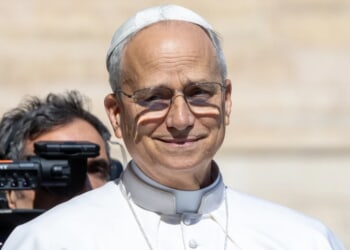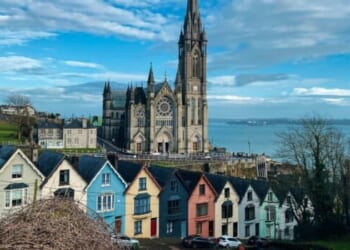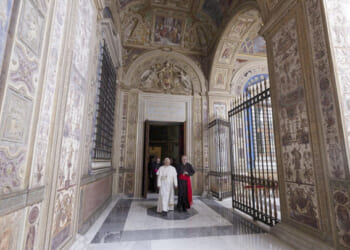These are the ones who, living in the flesh, planted the Church with their blood; they drank the chalice of the Lord and became the friends of God.
That is the Entrance Chant the Church gives us for the solemnity of Sts. Peter and Paul, one of the most ancient feasts on the Christian calendar. Martyred for Christ during the reign of the Emperor Nero, between 64-68 AD, June 29th has long been associated with the day of their dramatic deaths.
Since Paul was a Roman citizen, his death was quick. He was beheaded outside the walls of the city. But Peter was not a citizen. And as a scholar put it:
. . . for such people, the Romans had developed capital punishment to a high art, as in the slow, throat-parching, nerve-grating, and lung-drowning thing called crucifixion. (Anthony Esolen)
Speaking of high drama and high art: When the Hollywood actor-director Mel Gibson set out to make his 2004 movie The Passion of the Christ, he told his cinematographer that he wanted the film to look like a Caravaggio painting.
Michelangelo Merisi da Caravaggio was the most sought-after painter in Italy in the late 1500s and early 1600s. He was an artistic genius who pioneered bold new approaches to painting, working with extreme light and darkness to produce startingly lifelike and natural effects.
A scholar wrote that, much like his art, the man himself was equally dramatic, leading a life filled with danger, murder, and terror:
In a surviving description of his life from 1604, one observer wrote, “. . . after a fortnight’s work he will swagger about for a month or two with a sword at his side and a servant following him, from one ball-court to the next, ever ready to engage in a fight or an argument, so that it is most awkward to get along with him.”
When the pope declared a death sentence on Caravaggio after he killed a man in an illegal duel, Caravaggio fled Rome and never returned. He died under mysterious circumstances in 1610 at the age of 38.
In 1601, Caravaggio was commissioned to paint images for a church in Rome: one of Peter being crucified and one of Paul being converted. These two paintings remain in the church today, situated on each side of a beautiful altar up against the wall. The paintings, like most things in Rome, are huge—nine feet high and six feet wide.

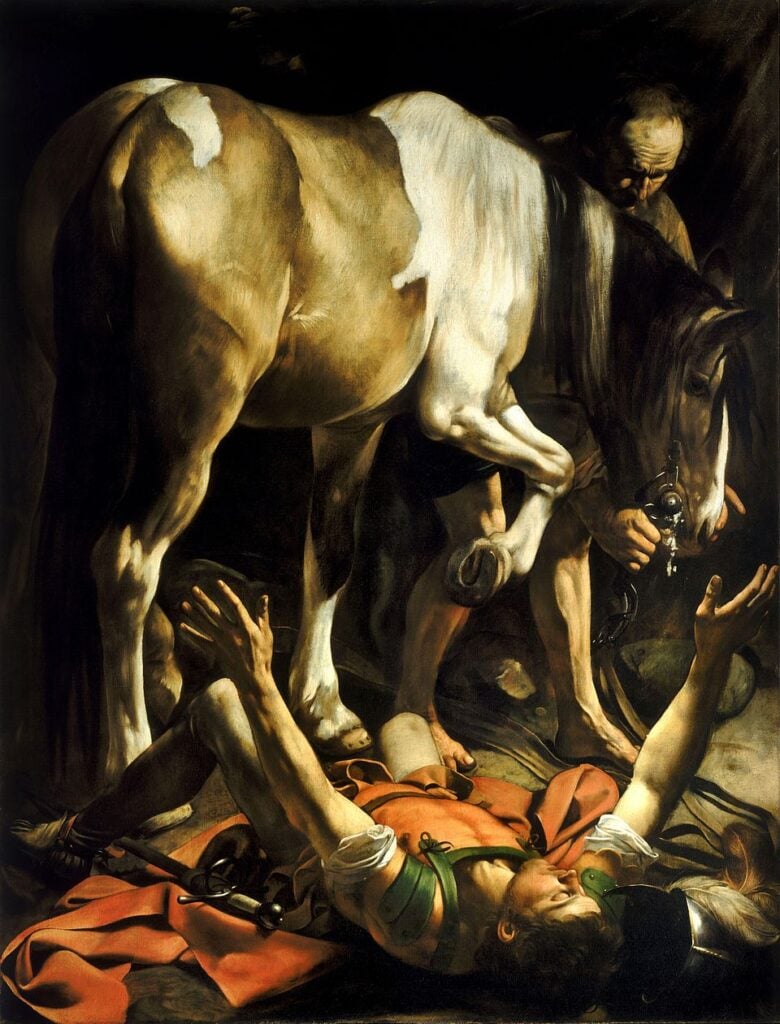
Notice in the St. Paul painting how most of the canvas is taken up by a huge horse, even including its rear end. And this was for a church! Caravaggio could get away with things like that. The realism and naturalism in the painting was part of the Catholic Counter Reformation, which included the battle against the whitewashing of walls and the destruction of sacred art which tragically occurred at the time of the Protestant revolt.
Under the horse is the fallen St. Paul, flat on his back, a peaceful look on his face, eyes closed, with arms raised in ecstasy. He is lying on a red cape, symbolizing blood, and he is dressed like a soldier, with a sword and a helmet near his head. A few spectators have commented to me that the painting is not accurate, since St. Paul was Jewish and not a Roman soldier. They are correct in stating it is not historically accurate. But the clever Caravaggio was not painting for accuracy, he was painting for theology.
With that said, when the altar boys observe me vest before Mass, they see me put a rectangular white cloth around my neck. Before I do that, I place the cloth, called an amice, on top of my head. The prayer that accompanies this action states: Lord, set the helmet of salvation on my head to fend off all the assaults of the devil. That “helmet of salvation” part comes from St. Paul. It’s from the 6th chapter of his letter to the Ephesians:
Put on the armor of God so that you may be able to stand firm against the tactics of the devil. For our struggle is not with flesh and blood but with the principalities, with the powers, with the world rulers of this present darkness . . . And take the helmet of salvation and the sword of the Spirit, which is the word of God. (cf. Eph. 6:10-18)

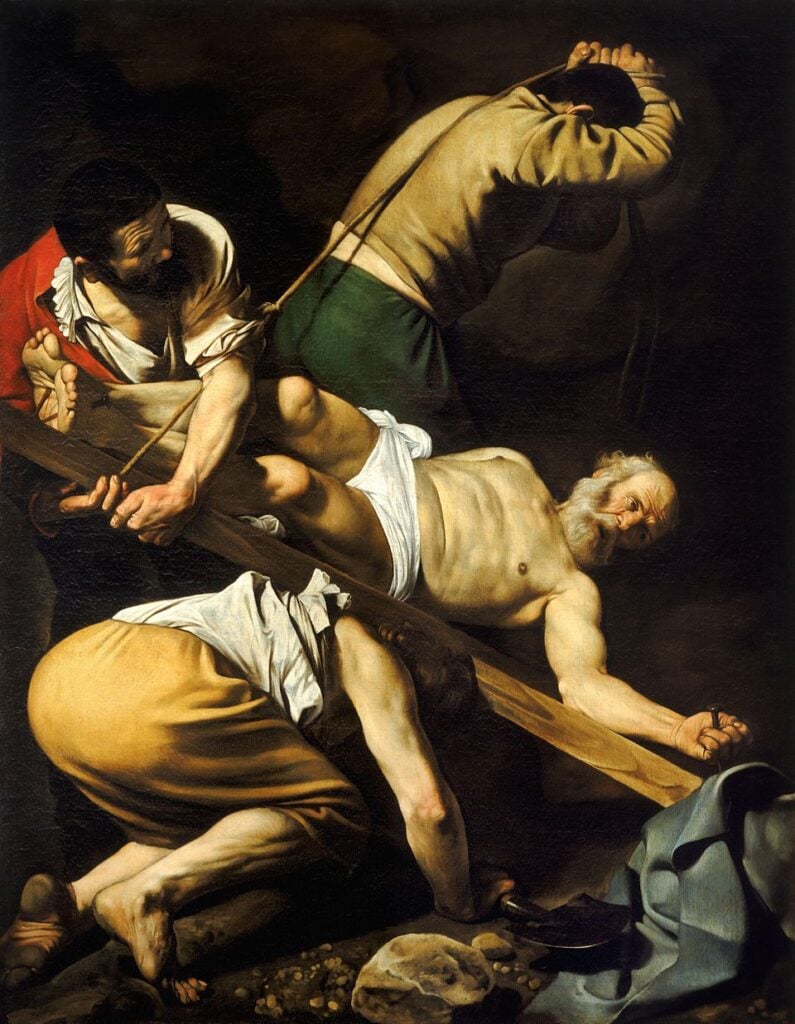
Like the St. Paul painting, the St. Peter one includes an intensely black background. In it, three men struggle and strain to lift the burly old fisherman, as he is nailed to a cross. The three’s faces are hidden in the darkness, while the light shines on Peter, who is set to hang, not as his Master did, but upside down. Peter was crucified in Emperor Nero’s Circus, which was an arena for chariot races. He would have hung just outside the present-day St. Peter Basilica in Rome. And it was there, in the flesh, that he planted the Church with his blood.
In Matthew 16:13, Christ gave us the Office of Peter to lead and unify His Church on earth—a Church that is not just a spiritual entity, but one, as St. Paul wrote, that is real, having a real body, with joints and ligaments. (Col. 2:19)
The first Peter failed miserably as pope the night before Christ died. This is portrayed in Caravaggio-like fashion in the movie The Passion of the Christ, when, after cursing and swearing Peter denies knowing Christ, he sees Him being led out of the high priest’s courtyard. The background canvas for the scene is dark, with light shining on Christ’s bloodied and bruised face, as He stares at a stunned Peter, who drops to his knees and then runs off and cries.
A scholar wrote:
No pope can betray Christ more than Peter did in that courtyard, no pope can follow Christ more than Peter, who got himself crucified on his account. The choice of Peter establishes the clear distinction, in the Church, between the office and the person. It is this principle that makes it possible to encounter the incarnate, grace-bestowing Christ even in unworthy human beings.
The choice of Peter also makes concrete the Catholic anthropology that sees man as weak and sinful, and yet called to pursue the highest perfection.
(Martin Mosebach)
My friends, there are no accidents with God. Christ was born and died during the Pax Romana, the Roman Peace, when Rome ruled the world, and all roads led to Rome. It was no accident that Paul was a Roman citizen. If not, he would have been killed by the Jews in Jerusalem, which was merely the capital of a small race of conquered people on the far eastern outskirts of the Roman Empire. Rome, the Eternal City, was the capital of the world. And Christ came to save the world.
He came to save you, who are weak and sinful, yet called to the highest perfection. This is why Christ gave you Peter the Rock and Paul the greatest of evangelists. This is why He gave you the Roman Catholic Church and the Holy Sacrifice of Mass, where His death is re-presented in a mystical manner, and bread and wine become His real Body and Blood.
How is that for high drama? How is that for high art? That is why the Roman Rite of Mass traditionally looked like a Caravaggio painting—intense and dramatic. For what happens at Mass is both intense and dramatic. How could it not be? It is the price of your salvation being played out right in front of you. It is the battle waged and won by the extreme light which overcomes this extreme present darkness.
Images from Wikimedia Commons












